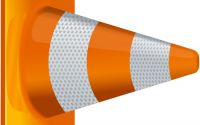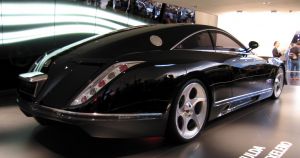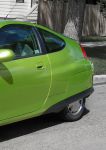Aerodynamics was first used to increase vehicle performance in race cars during the 1970s. Race car engineers realized that air flowing around the vehicle could be used to increase downforce and reduce aerodynamic drag on the car. As fuel economy became a strong factor in road vehicle design, engineers soon realized that the methods of reducing aerodynamic drag on race cars could be transferred to road vehicles in order to improve fuel economy. To decrease the amount of drag created by a vehicle, automobile manufacturers began incorporating vehicle body designs that would allow the vehicle to be more streamlined. Methods of decreasing the drag coefficient of a vehicle include re-shaping the rear end, covering the underside of the vehicles, and reducing the amount of protrusions on the surface of the car.
Aerodynamics and Fuel Economy
Imagine holding a large traffic cone outside of your car window while driving on a freeway at seventy-five miles per hour. You are given two options: either hold the cone so that the pointed end faces the same direction the car is moving, or so the pointed end faces away from the direction the car is moving (Fig. 1). In which scenario would it be easier to hold the cone, given the effects of air resistance? While intuition may cause many to think that holding the pointed end of the cone forward is more effective, the opposite is actually true. This phenomenon is an example of aerodynamic drag, the concept that engineers use to design the car’s shape and minimize the engine power needed to push the car forward.
Optimizing the shape of a vehicle to reduce aerodynamic drag can allow vehicle designers to build cars with increased fuel economy. Little effort is needed to reveal the ever-increasing importance of fuel economy for production vehicles. In 2004, the price for a barrel of crude oil was around $30, yet economists at the time projected this would increase dramatically in the future [1]. Just seven years later, the price for a barrel of crude oil is at $108 and increasing [2]. This 360-percent increase in the price of crude oil affects everyone who drives a car, which is a majority of the population in industrialized countries. In addition to the high price of gasoline, carbon dioxide emissions from the tailpipes of cars have been a concern from the standpoint of sustainability [3]. Better automotive aerodynamics lead to a reduction in fuel consumption, helping drivers save money and lowering carbon dioxide emissions.
Borrowed Technology
One important consideration that modern vehicle engineers take into account while designing a car is aerodynamics. Aerodynamics is the study of both the motion of air and the forces created on an object moving through air. When an automobile is in motion, a large amount of air is displaced and must flow around the vehicle. Although scientists and engineers have studied aerodynamics ever since the 19th century, the importance of aerodynamics on automobiles was only realized in the middle of the 20th century [4]. Race car engineers were among the first to analyze the interaction between the air flow around a vehicle and the resulting effects on vehicle performance; this analysis led to the beginning of the design of aerodynamic features for race cars in the late 1960s [5]. During this time, designers of race cars began to test their cars in wind tunnels to determine effects of the air flow on the vehicles. Engineers soon learned that incorporating aerodynamic elements into race cars would affect the cars by means of two phenomena: downforce and aerodynamic drag [5].
Downforce and aerodynamic drag are two of the forces created by the air that flows around the car. Downforce is the downward force on a vehicle created by a difference in air pressure and it can increase a car’s performance by increasing the force that presses the car to the ground. If there is a larger force pressing the tires of the car to the ground, the amount of friction and traction available to the tires is increased. Just as a wing on an airplane can create a lift force to allow the plane to take off, the same wing can be inverted on a car to create downforce. Although these inverted wings began to appear on many race cars in the 1970s, the downforce came at a cost—the wings increased the aerodynamic drag on the race cars [5]. Aerodynamic drag is the force that opposes the direction of motion of the vehicle. In order to incorporate inverted wings onto race cars without the sacrifice of too much induced drag, engineers devised methods of decreasing drag, thereby decreasing the engine power needed to maintain the vehicle at a certain speed. By reducing the drag on a car, the corresponding fuel economy would increase.
Thanks for the race car development divisions in most major production automakers, the aerodynamic improvements eventually found their way into passenger cars and production vehicles [5]. However, the main difference between the aerodynamics of a race car and the aerodynamics of a passenger car is that race cars aim to increase downforce, while passenger cars aim to decrease drag [6]. Therefore, automobile manufacturers borrowed much of what they learned about aerodynamics in race cars to decrease the aerodynamic drag in their production vehicles, thus improving the fuel economy of passenger cars.
The Relationship Between Drag and Fuel Economy
In order to decrease the aerodynamic drag on a vehicle, the sources of drag must be analyzed. As mentioned previously, aerodynamic drag is the force that opposes the direction of thrust of a car and is not a desirable force. Given a set of vehicle conditions, the drag force can be calculated. Drag is a function of the frontal area of the vehicle, the density of the air, the coefficient of drag of the vehicle, and the vehicle speed squared [5]. The effects of drag on a vehicle become even more prominent, however, when the engine power needed to overcome drag forces is realized. The engine power needed as a function of drag depends on the frontal area of the car, the density of the air, the coefficient of drag of the vehicle, and the vehicle speed cubed [4]. The fact that the vehicle speed has a cubic relation to the force of drag reveals that a small change in the speed of the car can require an enormous amount of engine power to overcome the forces of drag. In addition, the relation between drag and speed shows that aerodynamics of vehicles do not matter so much at lower speeds; they have a much more profound effect at highway speeds [4].
Now that the factors involved in creating drag have been analyzed, what can be done to decrease drag? While the density of air and the vehicle speed cannot be altered by the design of the vehicle, the frontal area and coefficient of drag can. Reducing the height and width of the car can reduce the frontal area, but there is a limit to how small this area can be since people must be able to sit comfortably inside the vehicle. Therefore, the easiest method of decreasing drag is to lower the coefficient of drag of the car [3]. The coefficient of drag of a vehicle depends predominantly on the shape (Fig. 2). Therefore, vehicle designers change specific aspects of the shape of the body of the vehicle in order to reduce the total aerodynamic drag and thus increase fuel economy.
Adjusting Vehicle Shape to Reduce Drag
The process of reducing the drag coefficient of a vehicle by altering the vehicle shape is called streamlining [4]. It was determined during the middle of the 20th century that the most streamlined shape is a teardrop (Fig. 3).
Although this design was emulated in various streamlined concept car models, the shape was found to be impractical when designing an actual car, mainly due to the long and narrow end. Instead, designers created cars with a profile more comparable to that in Fig. 4.
However, the air that flows around the car swirls around the rear much more for the actual vehicle profile as compared with the teardrop profile. These swirls are called vortices, and they represent a low-pressure area behind the car. The low pressure behind the car creates a suction effect that tries to pull the vehicle backwards [5]. Therefore, reducing the size of the separation zone, which is the area behind the car containing the vortices behind the car, is one of the predominant methods of decreasing aerodynamic drag. This can be done by slightly tapering the rear end of a car to reduce the size of the separation zone. As counterintuitive as it may seem, the rear section of the car is the cause of the most drag on a vehicle [3]. This is the same reason why the example of holding a traffic cone outside of a car window has less drag when pointed away from the direction a vehicle is moving. An example of streamlining a car by tapering the rear end of the vehicle can be noted by examining the design of the Maybach Exelero (Fig. 5).
Additional Methods of Drag Reduction
Another large source of drag comes from the underside of the vehicle and the wheel wells. When air travels under the car, it exerts pressure on all of the mechanical parts located beneath the car’s body, such as suspension components, axles, and the exhaust system [3]. In addition, the air that flows through the gaps between the wheels and the body of the car causes a further increase in drag for the car. Drag created in this area can contribute to up to one-sixth of the total drag on the vehicle [3]. With this in mind, engineers have designed various methods of reducing this drag. One method of preventing air from getting caught in mechanical devices under the car is to incorporate underside paneling [3]. Flat panels that prevent air from contacting the axles, the suspension, and the exhaust can significantly increase a vehicle’s ability to be streamlined. In addition to the mounting flat paneling under the car, wheel skirts can be attached to the rear wheel of a car as seen in the original model of the fuel-efficient Honda Insight (Fig. 6). The wheel skirt prevents air from flowing into the wheel arches, thus decreasing the overall drag on the vehicle.
In addition to streamlining the rear section of the car and the bottom of the car, another method of reducing drag is due to a phenomenon called skin friction. Since air is a viscous fluid, meaning that the air molecules can exert forces on one another, a thin layer of air will attach itself to the body of a vehicle in motion and exert a frictional force upon the vehicle. This section of slow-moving air located very close to the body of the car is called the boundary layer, and it increases the skin friction of the car, thus increasing the total drag a vehicle must overcome [5]. In order to reduce drag from skin friction, the surface of the car should be highly polished and clean, thereby reducing the amount of friction that the boundary layer can exert on the car [4]. In addition to having a highly polished surface, other small protrusions, such as screws, hinges, and gaps in the body work should also be minimized to reduce drag created from skin friction.
The Future of Vehicle Aerodynamics
Although aerodynamicists are reaching a limit to the lowest drag configurations possible in practical road vehicles, such as the Toyota Prius and Honda Insight, there are many innovative elements that automobile manufacturers design to incrementally decrease the drag coefficient of vehicles. New advancements in vehicle drag reduction are due significantly to the improvements of wind tunnels and advancements in simulation software [3]. Using equations and methods to analyze the fluid dynamics and thermal properties of air flowing around a vehicle, engineers can predict the effects of certain vehicle designs on the aerodynamics of a car. Therefore, using improved design tools, engineers continue to pursue vehicle designs with lower aerodynamic drag and develop cars to reduce the frequency of gas station stops that need to be made—helping not only the wallets of car owners, but also the health of the environment.









